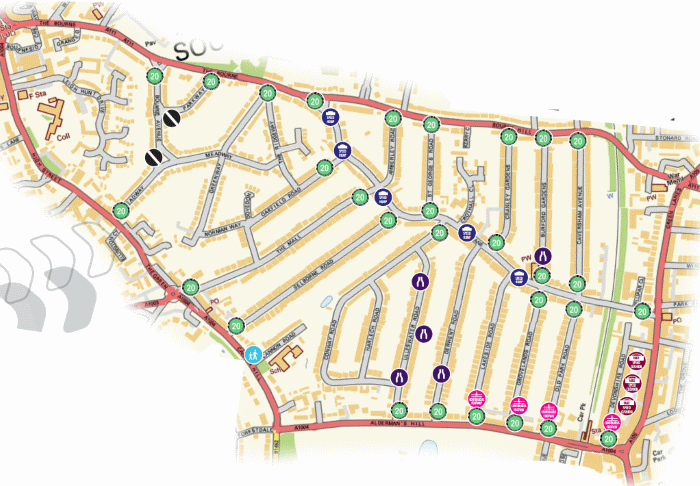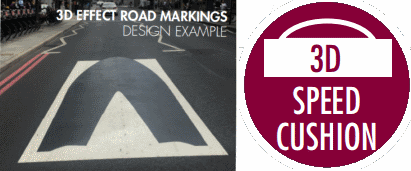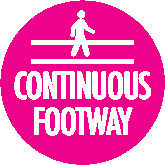Details of proposed measures to create the Fox Lane Quieter Neighbourhood were published this morning. Like last week's plans for the Fernleigh Road QN, they take a holistic approach to reducing vehicle speeds along side roads throughout the large area covered, which stretches from Palmers Green Triangle nearly all the way to Southgate Circus.
Some of the traffic calming measures are familiar from the three previous QN proposals: speed humps (confined to Fox Lane itself), road narrowing, point no entries and a school street (affecting St Monica's). However, the consultation introduces some novel ideas.
All roads leading into the QN would have "entry points" consisting of a planter with low-level planting placed in the road. These planters will have neighbourhood signs to encourage drivers to stay below 20mph. The planters would require drivers entering the area to give way to those leaving. All turnings off Fox Lane would also be treated with entry points. The intention is evidently to make using the area as a shortcut between Aldermans Hill and Bourne Hill a less attractive option for drivers.
The other novel idea is the use of "3D-effect road markings", also referred to as "3D speed cushions". These use a "trompe l'oeil" effect to make a flat surface appear to be curved and have reportedly proved effective in reducing speeds in other parts of London. They would be introduced as an experiment in Devonshire Road.
The deadline for responding to the consultation is 26th November.
NEIGHBOURHOOD ZONE
 Residents expressed a wish to see the area covered by a 20mph zone to address their concerns about the speed and volume of through traffic in the area. However, they also did not want a lot of traffic calming features. To respond to this we propose to create entry points to the area indicating to drivers that this is a residential area. Each entry point will consist of a planter with low-level planting placed in the road. These planters will have neighbourhood signs which will encourage drivers to stay below 20mph. These planters will require drivers entering the area to give way to those leaving. Planters will be placed at junctions within the existing double yellow line areas so will not reduce parking. Planters will be maintained by the Council, but opportunities for community gardening can be explored. The location of the planters will remain flexible and we will monitor their placement to gain a greater understanding of the impact they may have. This could lead to trials where additional planters are placed along the length of residential streets and/or the existing planters are re-positioned to help further reduce traffic speeds/volume. Any additional measures such as these would see further community engagement.
Residents expressed a wish to see the area covered by a 20mph zone to address their concerns about the speed and volume of through traffic in the area. However, they also did not want a lot of traffic calming features. To respond to this we propose to create entry points to the area indicating to drivers that this is a residential area. Each entry point will consist of a planter with low-level planting placed in the road. These planters will have neighbourhood signs which will encourage drivers to stay below 20mph. These planters will require drivers entering the area to give way to those leaving. Planters will be placed at junctions within the existing double yellow line areas so will not reduce parking. Planters will be maintained by the Council, but opportunities for community gardening can be explored. The location of the planters will remain flexible and we will monitor their placement to gain a greater understanding of the impact they may have. This could lead to trials where additional planters are placed along the length of residential streets and/or the existing planters are re-positioned to help further reduce traffic speeds/volume. Any additional measures such as these would see further community engagement.




 Narrowing the road helps to reduce speeds, in several streets in the Fox Lane area we will reduce the width of the road by widening existing parking bays. Where marked parking bays already exist, we propose to widen these further to help reduce speeds in these streets.
Narrowing the road helps to reduce speeds, in several streets in the Fox Lane area we will reduce the width of the road by widening existing parking bays. Where marked parking bays already exist, we propose to widen these further to help reduce speeds in these streets. To reduce speeds on Devonshire Road (which is a one-way street) we propose to trial the use of painted 3D speed cushion road markings. In other London boroughs these have reduced speeds by several miles per hour without resorting to physical measures.
To reduce speeds on Devonshire Road (which is a one-way street) we propose to trial the use of painted 3D speed cushion road markings. In other London boroughs these have reduced speeds by several miles per hour without resorting to physical measures. A point no-entry is used to prevent traffic travelling past a defined point in one direction while allowing traffic to continue in the opposite direction. A point no-entry is usually formed using a kerbed buildout to narrow the road, which may result in the loss of one or two on-street parking spaces. This is being proposed in response to residents’ concerns about the volume of through traffic using Bourne Avenue and Meadway.
A point no-entry is used to prevent traffic travelling past a defined point in one direction while allowing traffic to continue in the opposite direction. A point no-entry is usually formed using a kerbed buildout to narrow the road, which may result in the loss of one or two on-street parking spaces. This is being proposed in response to residents’ concerns about the volume of through traffic using Bourne Avenue and Meadway. A speed hump is a traditional traffic calming feature used to slow traffic. Humps are typically round-topped and stretch across the width of the road. In response to residents’ concerns, we will be using a particular type of speed hump which is better for cyclists, and reduces noise and vibration to nearby residents. We are proposing to introduce speed humps in Fox Lane to ensure that our traffic management measures do not result in increased speeds.
A speed hump is a traditional traffic calming feature used to slow traffic. Humps are typically round-topped and stretch across the width of the road. In response to residents’ concerns, we will be using a particular type of speed hump which is better for cyclists, and reduces noise and vibration to nearby residents. We are proposing to introduce speed humps in Fox Lane to ensure that our traffic management measures do not result in increased speeds. Continuous footways are made of materials similar to that of the surrounding footpath and vehicles are encouraged to give way to pedestrians who are using the footpath. This series of continuous footways will create an improved environment for pedestrians, linking the high street to the zebra crossing which provides access into Broomfield Park.
Continuous footways are made of materials similar to that of the surrounding footpath and vehicles are encouraged to give way to pedestrians who are using the footpath. This series of continuous footways will create an improved environment for pedestrians, linking the high street to the zebra crossing which provides access into Broomfield Park.